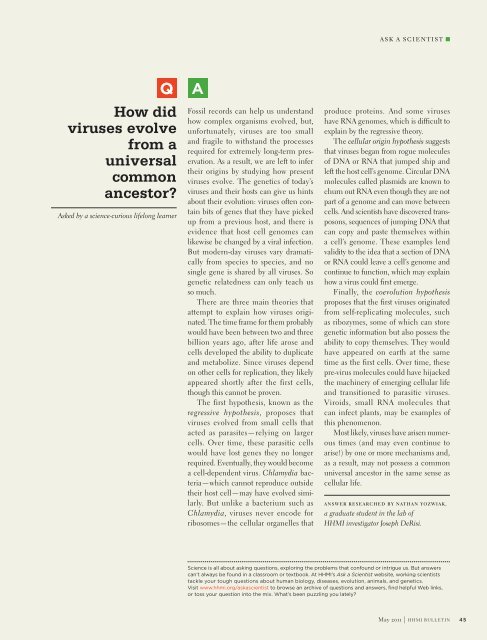Download PDF - Howard Hughes Medical Institute
Download PDF - Howard Hughes Medical Institute
Download PDF - Howard Hughes Medical Institute
Create successful ePaper yourself
Turn your PDF publications into a flip-book with our unique Google optimized e-Paper software.
ask a scientist<br />
q<br />
How did<br />
viruses evolve<br />
from a<br />
universal<br />
common<br />
ancestor?<br />
Asked by a science-curious lifelong learner<br />
A<br />
Fossil records can help us understand<br />
how complex organisms evolved, but,<br />
unfortunately, viruses are too small<br />
and fragile to withstand the processes<br />
required for extremely long-term preservation.<br />
As a result, we are left to infer<br />
their origins by studying how present<br />
viruses evolve. The genetics of today’s<br />
viruses and their hosts can give us hints<br />
about their evolution: viruses often contain<br />
bits of genes that they have picked<br />
up from a previous host, and there is<br />
evidence that host cell genomes can<br />
likewise be changed by a viral infection.<br />
But modern-day viruses vary dramatically<br />
from species to species, and no<br />
single gene is shared by all viruses. So<br />
genetic relatedness can only teach us<br />
so much.<br />
There are three main theories that<br />
attempt to explain how viruses originated.<br />
The time frame for them probably<br />
would have been between two and three<br />
billion years ago, after life arose and<br />
cells developed the ability to duplicate<br />
and metabolize. Since viruses depend<br />
on other cells for replication, they likely<br />
appeared shortly after the first cells,<br />
though this cannot be proven.<br />
The first hypothesis, known as the<br />
regressive hypothesis, proposes that<br />
viruses evolved from small cells that<br />
acted as parasites—relying on larger<br />
cells. Over time, these parasitic cells<br />
would have lost genes they no longer<br />
required. Eventually, they would become<br />
a cell-dependent virus. Chlamydia bacteria—which<br />
cannot reproduce outside<br />
their host cell—may have evolved similarly.<br />
But unlike a bacterium such as<br />
Chlamydia, viruses never encode for<br />
ribosomes—the cellular organelles that<br />
produce proteins. And some viruses<br />
have RNA genomes, which is difficult to<br />
explain by the regressive theory.<br />
The cellular origin hypothesis suggests<br />
that viruses began from rogue molecules<br />
of DNA or RNA that jumped ship and<br />
left the host cell’s genome. Circular DNA<br />
molecules called plasmids are known to<br />
churn out RNA even though they are not<br />
part of a genome and can move between<br />
cells. And scientists have discovered transposons,<br />
sequences of jumping DNA that<br />
can copy and paste themselves within<br />
a cell’s genome. These examples lend<br />
validity to the idea that a section of DNA<br />
or RNA could leave a cell’s genome and<br />
continue to function, which may explain<br />
how a virus could first emerge.<br />
Finally, the coevolution hypothesis<br />
proposes that the first viruses originated<br />
from self-replicating molecules, such<br />
as ribozymes, some of which can store<br />
genetic information but also possess the<br />
ability to copy themselves. They would<br />
have appeared on earth at the same<br />
time as the first cells. Over time, these<br />
pre-virus molecules could have hijacked<br />
the machinery of emerging cellular life<br />
and transitioned to parasitic viruses.<br />
Viroids, small RNA molecules that<br />
can infect plants, may be examples of<br />
this phenomenon.<br />
Most likely, viruses have arisen numerous<br />
times (and may even continue to<br />
arise!) by one or more mechanisms and,<br />
as a result, may not possess a common<br />
universal ancestor in the same sense as<br />
cellular life.<br />
Answer Researched by Nathan Yozwiak,<br />
a graduate student in the lab of<br />
HHMI investigator Joseph DeRisi.<br />
Science is all about asking questions, exploring the problems that confound or intrigue us. But answers<br />
can’t always be found in a classroom or textbook. At HHMI’s Ask a Scientist website, working scientists<br />
tackle your tough questions about human biology, diseases, evolution, animals, and genetics.<br />
Visit www.hhmi.org/askascientist to browse an archive of questions and answers, find helpful Web links,<br />
or toss your question into the mix. What’s been puzzling you lately?<br />
May 2o11 | h h m i b u l l e t i n<br />
45
















